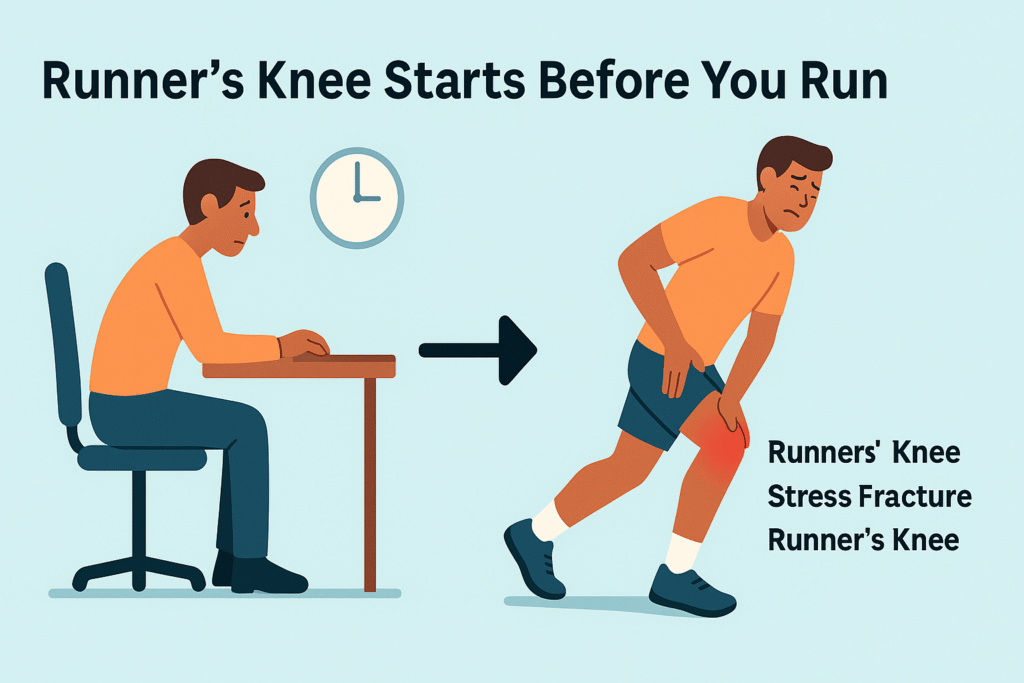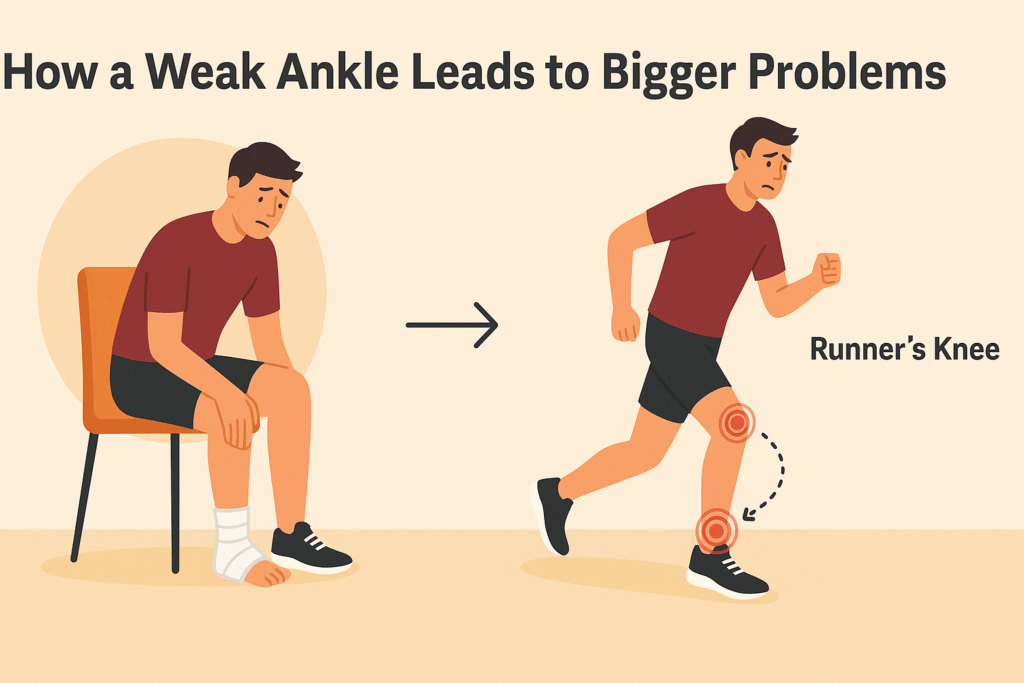
Ever notice a strange ache in your foot that disappears after a couple of miles? Or a dull knee pain that flares up during downhill runs?
While running offers tremendous physical benefits, it can also wear down your body if you ignore early warning signs and even small injuries matter.
Most running injuries develop gradually from small imbalances in form, training volume, or recovery. And the majority are highly preventable with smart adjustments in technique, strength, and footwear.
This article breaks down 9 of the most common running injuries, what causes them, and how to prevent them using clinically supported strategies from chiropractic and sports medicine perspectives.
Whether you’re new to running or returning from a setback, understanding these patterns can help you avoid long-term issues and keep your running routine consistent.
Key Takeaways
- Most running injuries come from overuse, not sudden accidents.
- Shin splints, runner’s knee, plantar fasciitis, and Achilles pain are among the most common issues.
- Weak or tight muscles, poor running form, and sudden increases in mileage are major risk factors.
- Prevention starts with slow progression, strength training, recovery, and the right running shoes.
- Listen to your body. If something feels off, modify your training before it becomes a bigger issue.
Why Running Injuries Happen

Running injuries rarely result from a single misstep. Most develop gradually due to repetitive stress on the same tissues, especially when training loads increase too quickly or recovery is cut short.
According to a large-scale review, nearly 44% of runners experience overuse injuries, with the knee, shin, foot, and Achilles tendon being the most commonly affected areas.
One of the most common risk factors is doing too much too soon, particularly for beginners or runners coming back from a break. Stacking multiple long runs in one week without proper buildup can overload joints, tendons, and connective tissue.
Biomechanics also plays a major role. Poor running form, muscle imbalances, and limited mobility place extra stress on specific areas. Over time, this wear and tear often leads to injury in the knees, hips, shins, or feet.
Quick Tip: Clarify your long-term goal. Are you training for one race and calling it quits, or do you want to keep running for years? If it’s the latter, focus on building a strong foundation at a sustainable pace. Pushing too fast too soon is one of the quickest ways to end up with one of the nine common injuries runners face.
9 Common Running Injuries
1. Shin Splints (Medial Tibial Stress Syndrome)
Shin splints are one of the most common lower leg injuries in runners, especially those doing long-distance training or increasing mileage too fast. Pain usually shows up along the inner edge of the shin and worsens during or after a run.
They’re often caused by repetitive impact, worn-out shoes, or weak calf muscles. A lesser-known factor is an undertrained tibialis anterior—the muscle along the front of your shin that helps lift the foot. When it fatigues, your form may change, putting more strain on the calves and lower leg.
Proper rest and recovery are key. Here’s how to accelerate healing from a sports injury without losing all your training momentum.
If ignored, shin splints can turn into stress fractures. Prevention includes building mileage gradually, running on softer surfaces, and strengthening both the front and back of your lower legs.
2. Stress Fractures
Stress fractures are tiny cracks in bones caused by repeated impact and not enough recovery time. They often affect the tibia, metatarsals, or hip in runners who increase mileage too quickly.
Early signs may feel like a dull ache or deep nagging pain. Many runners can still train through it at first, which makes it easy to miss. As the injury progresses, the pain becomes sharper and sticks around after rest. These injuries are often missed on X-rays, so an MRI may be needed for confirmation.
Quick Tip: Sometimes your body just needs rest—even if your mind is saying go. Trust your instincts when something feels off.
3. Runner’s Knee (Patellofemoral Pain Syndrome)
Runner’s knee causes anterior knee pain, or pain around or behind the kneecap, especially when walking down stairs, squatting, or sitting with the knee bent for long periods.
It’s often linked to weak hips, poor alignment, or overuse from activities such as downhill running. Weak glute medius, TFL, or adductors can cause the knee to drift inward or outward, changing how the kneecap moves and putting stress on the joint.

Many runners who sit at a desk all day have underactive hips and core muscles. Without training the right muscle groups, even light jogging can start to wear down the knees.
The exact cause of runner’s knee is tough to pin down, so general strengthening is the best approach. Focus on the quads, glutes, and hips, and wear running shoes that support proper alignment.
If the pain sticks around, these exercises to alleviate knee pain can help retrain your mechanics and reduce irritation.
4. IT Band Syndrome
IT Band Syndrome causes lateral knee pain, often described as sharp or stabbing, especially during or after runs. It’s a common overuse injury among long-distance runners.
The IT band is a thick band of tissue running from the hip to the shin. When it becomes too tight, it rubs against the outside of the knee, leading to irritation and inflammation. In some cases, this tension can even cause discomfort on the inside of the knee due to altered mechanics.
Risk factors include weak hips, excessive downhill running, and poor movement control during strides.
Stretching, foam rolling, and strengthening the glutes and lateral hip muscles can help reduce IT band tightness and minimize lateral knee pain over time.
5. Achilles Tendon Injuries
Achilles tendon pain is common in runners who ramp up training intensity too quickly. It often shows up as stiffness or swelling near the back of the heel, especially during early morning steps or the start of a run.
Tight calves, poor ankle mobility, and overstriding can all contribute. Even tight hip flexors from sitting too much can affect posture and running form, placing more strain on the Achilles.
Quick Tip: If you often tuck your feet under your chair while sitting, break that habit. It puts your calves in a shortened position, which can increase Achilles tension over time.
Try slow, controlled heel drops, ankle mobility drills, calf stretches, and supportive shoes to ease tension and keep your Achilles healthy.
6. Plantar Fasciitis
Plantar fasciitis causes sharp heel pain, especially with your first steps in the morning. It’s one of the most common overuse injuries among runners.
This condition is often triggered by tight calves, flat feet, or sudden increases in mileage. Worn-out or unsupportive running shoes can make it worse.
To prevent it, strengthen the calves and foot arch, wear running shoes with proper support, and increase training volume gradually.
Quick Tip: Roll the bottom of your foot regularly with a frozen water bottle or PVC pipe to reduce tension and inflammation. You might find relief with these natural remedies for plantar fasciitis and recovery-focused foot care.
7. Hip Flexor Strain
Tight or weak hip flexors can lead to pain at the front of the upper leg, especially when running uphill or sprinting.
This injury often stems from poor core or glute strength and long hours of sitting. Weak hip flexors can limit stride power and overload other nearby muscles.
To prevent issues, strengthen the full hip complex, work on mobility, and build up hill workouts gradually.
8. Ankle Sprains

While less common than overuse injuries, ankle sprains still happen often—especially on trails or uneven pavement.
Ankle sprains can weaken the joint long after the pain fades — especially if you’ve had recurring injuries or needed recovery after ankle surgery. Without proper rehab, instability increases your risk of re-injury during runs.
To prevent future sprains, include ankle mobility, strength work, and balance training in your routine. Good footwear with solid traction also goes a long way.
9. Degenerative Knee Irritation (Meniscus or ACL Wear)
Although less common in runners, gradual meniscus wear can occur over time—especially with poor form, previous knee injuries, or excessive mileage without rest.
Symptoms often include deep knee pain, clicking, or stiffness. If not managed properly, the damage can worsen and may eventually require surgical intervention.
Focus on joint-friendly surfaces, proper form, ACL prevention, and strength training to reduce knee stress.
When to Rest, Modify, or Seek Help

If pain shows up on every run or starts to change how you move, it’s time to back off. Discomfort that lingers or alters your stride isn’t just soreness — it’s your body asking for rest.
Running should feel enjoyable and energizing, especially if you’re doing it for general fitness or fun. If you’re training for a race like a marathon, it’s a different story. Higher mileage (often 26+ miles per week) means being even more careful about recovery, especially in the final weeks.
Taking a few days off to properly recover from your run is often the smartest move for getting back on track. Reassessing your form or adding strength work can help prevent small issues from turning into long-term injuries.
And when in doubt, consulting a chiropractor, sports medicine specialist, or scheduling a physical therapy evaluation is a smart step toward early injury prevention.
Wrap Up
Most running injuries are preventable. With early awareness, smart mileage progression, and strength-focused training, you can reduce setbacks and stay consistent.
A solid foundation in form, recovery, and movement control goes a long way toward keeping your running routine smooth and injury-free for the long haul.
FAQ: Common Questions About Running Injuries
1. How do I know if it’s just soreness or a real running injury?
Muscle soreness and tight calf muscles usually fade in 1–2 days. But if you feel sharp or lingering dull pain—especially around the shin bone or knee—it may be a common overuse injury like shin splints or patellofemoral pain syndrome. Rest and consider professional care if pain changes your form.
2. Can I run through minor leg pain?
It’s risky. Running with lower leg pain, Achilles tendon pain, or plantar fasciitis may lead to stress fractures or related injuries. Adjust your running routine and training volume before returning.
3. How do I prevent running injuries long-term?
Focus on injury prevention by building up running volume slowly, strengthening calf and gluteal muscles, improving running form, and using proper running shoes. Add cross-training and physical therapy as needed.
Author Box
Dr. Jay Tan is a licensed chiropractor and the founder of TanEMP, where he shares evidence-based recovery strategies and beginner-friendly running tips. As both a healthcare professional and a casual runner, he’s passionate about helping others move better, feel better, and stay consistent with their goals.
For more beginner guidance, check out his post on proper running form.
Note: This article is based on clinical experience and general educational insights. It is not a substitute for personalized medical advice. Please consult a healthcare provider before starting a new exercise routine or if you’re experiencing pain.

